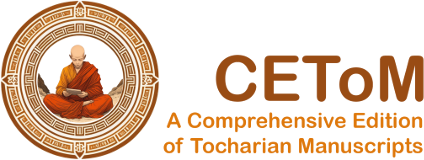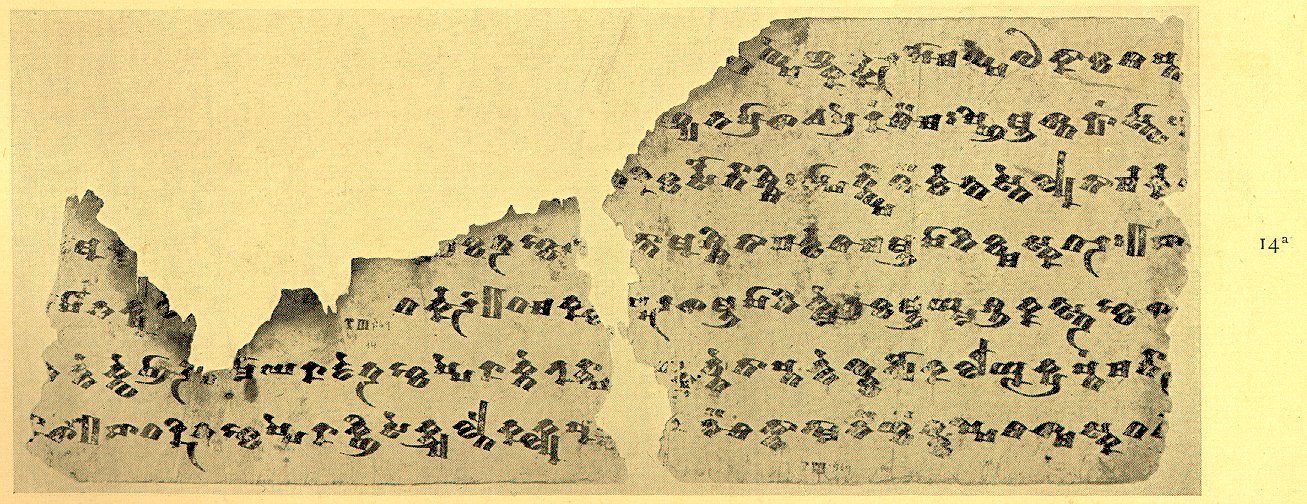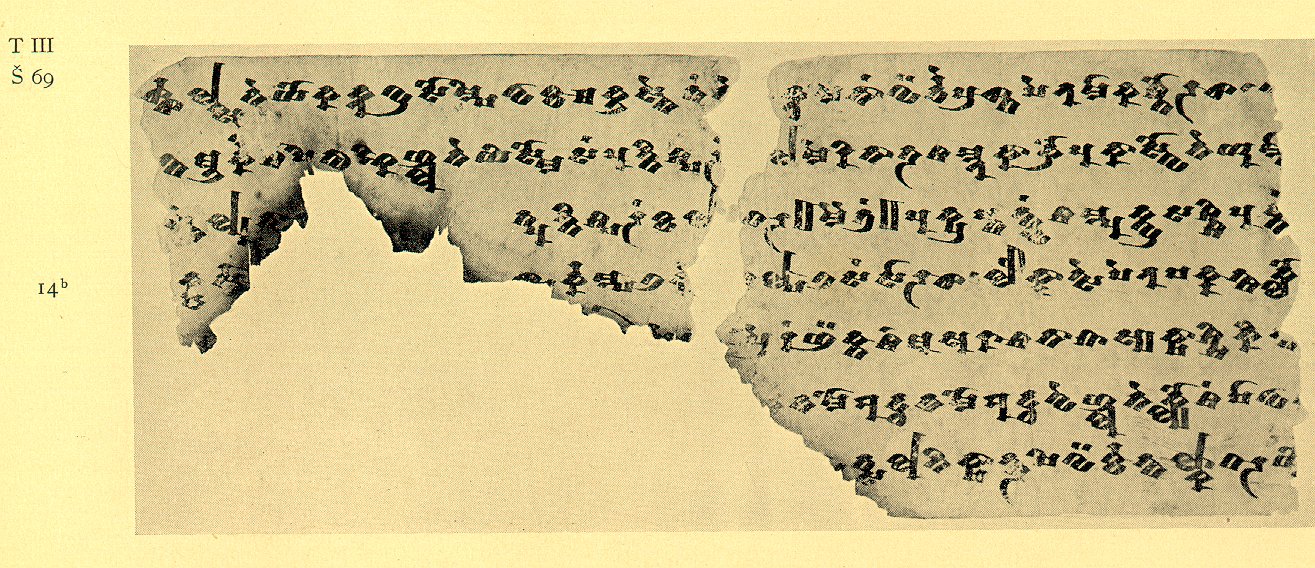A 214
| Known as: | A 214; THT 847 |
|---|---|
| Cite this page as: | Gerd Carling. "A 214". In A Comprehensive Edition of Tocharian Manuscripts (CEToM). Created and maintained by Melanie Malzahn, Martin Braun, Hannes A. Fellner, and Bernhard Koller. https://cetom.univie.ac.at/?m-a214 (accessed 03 Jul. 2025). |
Edition | |
| Editor: | Gerd Carling |
Provenience | |
| Main find spot: | Shorchuk |
| Specific find spot: | Stadthöhle |
| Expedition code: | T III Š 69.14 |
| Collection: | Berlin Turfan Collection |
Language and Script | |
| Language: | TA |
| Script: | classical |
Text contents | |
| Title of the work: | Maitreyasamiti-Nātaka |
| Passage: | Act 2.1 |
| Text genre: | Literary |
| Text subgenre: | Drama |
| Verse/Prose: | prose; verse |
| Meter: | 543 (4x) |
Object | |
| Manuscript: | M-α |
| Material: | ink on paper |
| Form: | Poṭhī |
| Number of lines: | 7 |
Images
Images from titus.fkidg1.uni-frankfurt.de by courtesy of the Thesaurus Indogermanischer Text- und Sprachmaterialien (TITUS).
Transliteration
| a1 | /// nta wṣe ñka tka¯ ¯r ṣo¯ ¯m wṣe o kā¯ ¯k na ṣta /// |
|---|---|
| a2 | /// ñya na prā¯ ¯s̝ e pre raṃ śä¯ ¯m : ṣñi ā s̝ta ryāṃ swā [ñce] /// |
| a3 | /// dha ri ka rso rtā śśi : spā rtwṣā wä rka¯ ¯nt sne lyu tā rma rka /// |
| a4 | /// a kma – – – – ·m· [tra]¯ ¯k tra ṅka¯ ¯s̝ – ntā a śśi tā pa¯ ¯rk sa¯ ¯m ā ṣā ni kma ska ta¯ ¯r : || bā /// |
| a5 | /// ṣā na kṣu [l]· – – ta rka¯ ¯r || ta¯ ¯m ka· l· ṣu ra¯ ¯s̝ ā ṣā ni kme tra¯ ¯k ā yma śla kka tstra ṅka¯ ¯s̝ /// |
| a6 | /// ·[ta] nne kwe ñā¯ ¯r || mā gha rā je tra ṅka ṣpe rā kte nu upā – yku cne tā ṣta nne wka nyo ka lī yū kpra ṣtaṃ ma rtā [ra] /// |
| a7 | /// ··ā¯ ¯s̝ || bā dha ri tra ṅka ṣpe rā kñi se kuya lte ka klyu ṣu – – [ṣ]· nä¯ ¯s knā nmā nä ñcä ska ṣṣi sa s̝ma ska ta r·· /// |
| b1 | /// rs̝s̝a ltsu ne yo ka knu wra so mṣi wā ka¯ ¯m ku sne taṃ ne – (–) [knu] mi nāṃ wä rce pra¯ ¯s̝t pe nu mā ka śto ra¯ ¯s̝ • [w]· /// |
| b2 | /// nta ā rki śo ṣi tu ṅki ñlu ne yi smo saṃ pu tti śpa raṃ – la me ri nā tra sa mnu kā kro pu kā swo ne yu m·ā /// |
| b3 | /// sne lyu tā¯ ¯r – – tpu tti śpa raṃ ka l·· ta¯ ¯r || mai traṃ || pu kpra ṣta ntwaṃ sa mpu kwra sa śśi pu kw[ä] /// |
| b4 | /// kka rsnā¯ – – – – s̝[m]a rka mpa¯ ¯l ke – [śa] lpa¯ ¯l saṃ sā ra¯ ¯s̝ : lo kkā tse pe nu ṣa kka¯ ¯ts klo /// |
| b5 | /// [o] [ṣe] [ñi] e pre raṃ ñä kta¯ ¯s a su rā¯ ¯s nā gā sya kṣā śśi ki [nna] /// |
| b6 | /// na mo bu ddha na mo bu ddha we ñlu ne klyo saṃ ṣā wā /// |
| b7 | /// csa lu ni kṣā ntra ṣi wä rka¯ ¯nt lkā ta¯ ¯r y·o /// |
Transcription
| a1 | /// nt{†ä} wṣeñ katkar ṣom wṣe okāk näṣ ta /// |
|---|---|
| a2 | /// ñy anaprāṣ epreraṃ śäm : ṣñi āṣtäryāṃ swāñce /// |
| a3 | /// (bā)dhari kärsor tāś-śi : spārtwṣā wärkänt sne lyutār märka /// |
| a4 | /// akma – – – – ·m· trak träṅkäṣ – ntā aśśi tāpärk säm āṣānik mäskatär : ॥ bā /// |
| a5 | /// (pā)ṣānak ṣul· – – tär kar ॥ täm ka(k)l(yu)ṣuräṣ āṣānik metrak āymaśl-äkk ats träṅkäṣ /// |
| a6 | /// · tanne-k weñār ॥ māgharāje träṅkäṣ perāk te nu upā(dhyā)y kuc ne tāṣ tanne wkänyo kalīyūk praṣtaṃ märtārä /// |
| a7 | /// ··āṣ ॥ bādhari träṅkäṣ perāk ñi se kuyalte kaklyuṣu (ñi) (ne)ṣ(i)näs knānmānäñcäs käṣṣisäṣ mäskatär·· /// |
| b1 | /// rṣṣältsuneyo kaknu wrasomṣi wākäm kus ne taṃne – – knumināṃ wärce praṣt penu mā kaś toräṣ • w· /// |
| b2 | /// nt{†ä} ārkiśoṣi tuṅkiñluneyis mosaṃ puttiśparäṃ – lame rināträ säm nu kākropu kāswoneyum ·ā /// |
| b3 | /// sne lyutār – – t puttiśparäṃ käl(pnā)tär ॥ maitraṃ ॥ |
| 1a | puk praṣtäntwaṃ säm ; puk wrasaśśi ; puk wä(knā) (:) |
|---|---|
| 1b | /// b4 9σ /// k ; kärsnā(l) – – 1σ |
| 1c | – – ṣ märkampal ; ke – śalpal ; saṃsāräṣ : |
| 1d | lok kātse penu ; ṣakk ats klo /// 4σ |
| b5 | /// oṣeñi epreraṃ ñäktas asurās nāgās yakṣāśśi kinna(res) (gandhārveśśi) (yoṣ) (ymāṃ) (wsālwäṣ) /// |
|---|---|
| b6 | /// namo buddha namo buddha weñlune klyosäṃṣāwā /// |
| b7 | /// c salu nikṣānträṣi wärkänt lkātär y·o /// |
Translation
| a1 | nights have passed. (Not) one (single) night (did) I (sleep) so (well) ... |
|---|---|
| a2 | ... from before me, he stood in the sky. ... (with) his own pure ray |
| a3 | ... Bādhari, you shoud know: I was turning (?) the peerless (dharma)-wheel... |
| a4 | ... face... Maitreya says: ... Where then is at this moment this venerable one? |
| a5 | «He is on Mount Pāṣāṇaka (in the lands of Magadha)». || ... Having heard that, the venerable Maitreya says to himself: |
| a6 | ... they said so: Māgharāja says: |
| a6+ | «O teacher, is it to believed that in such a Kaliyuga era, in a short (lifetime a Buddha will appear in the world?)» |
| a7 | Bādhari says: It is credible to me, son, because I have heard from previous knowledgeable teachers... |
| b1+ | ... the distinction of a person endowed with power, who, not minding that the epoch is so bad, ... out of love for the... world renounces the position of Buddhahood. |
| b2+ | He, having gathered virtues, ... obtains the peerless... Buddhahood. |
| b3 | In the maitär*-tune: At all times, he is known... to all beings in all manners... |
| b4 | ... law... who is to be liberated from saṃsāra... Far and close, certainly... (hear?)... |
| b5 | (by day and) night, in the sky, (proceeding from the garments) of the gods, the Asuras, the Nāgas, and the Yakṣas, of the Kinnaras (and the Gandharvas) |
| b6 | I was hearing chanting "namobuddha namobuddha"... |
| b7 | ... the whole star-wheel is visible... |
Other
| a3 | The Buddha-god the teacher has appeared in the world, o Bādhari, you should know that! (Peyrot 2013b: 624) |
|---|---|
| a4+ | Bādhari says, «He is on Mount Pāṣāṇaka in the lands of Magadha». (cf 69) (Peyrot 2013b: 284) |
| a6 | O teacher, is it to believed that in such a Kaliyuga era, in a short (lifetime a Buddha) will appear in the world? (69) (Peyrot 2013b: 632) |
| b2 | ... aus Liebe zu der (elenden) Welt strebt er zum Ort der Buddhaschaft/wird der Ort der Buddhaschaft erstrebt.. (Schmidt 1974: 150) |
| b7 | ... vollständig ist der Sternenkreis sichtbar. (Schmidt 1974: 233) |
Commentary
Remarks
| Transcription and references have been transferred from the "Text and Reference Database of the Tocharian A Language" (Gerd Carling Lund University) (funded by the Bank of Sweden Tercentenary Foundation and SCAS). | |
| Transcription and translation are based on Carling et al. 2009. |
Parallel texts
| YQ II.1; YQ II.2; MaitrHami 2, 1-2 |
Philological commentary
| This fragment contains part of the second act of the Maitreyasamitināṭaka. It correlates to YQ II.1 a4 - YQ II.2 a2; an Uy. parallel is MaitrHami II, 1a18-2a14. See also Pinault 1999: 193-4. |
References
Online access
Edition
Sieg and Siegling 1921: 103-104; Ji et al. 1998: 68; Sieg and Siegling 1921 p. 103, p. 104
Translations
Adams 2012a: a2 (28); Carling 2000: a1 (302), a2 (138, 356); Hackstein 1995: a2 (125), b2 (182); Ji et al. 1998: a1 a2 a3 a4 a5 a6 a7 b1 b2 b3 b4 b5 b6 b7 (69ff); Knoll 1996: a6 (34), a7 (34); Kölver 1965: a2 (104), a5 (73), a6 (13); Peyrot 2013b: a3 (624), a4 a5 (284), a6 (632); Schmidt 1974: b2 (150), b7 (233); Thomas 1954: a1 (749); Thomas 1957: a5 a6 (190), b6 (67); Thomas 1969c: a1 (200); Thomas 1981: a3 (491); Thomas 1983: b1 (19); Thomas 1990: a1 (30), a3 (31), a3 (32), a4 (32), a4 (65), a5 (32), a6 a7 (33), a6 a7 (69), a7 (33), b2 (34), b3 (34), b4 (35); Thomas 1991: b6 (22); Thomas 1997: b3 (139)
Bibliography
Adams, Douglas Q. 2012a. “Shedding light on *leuk- in Tocharian and Hittite and the wider implications of reconstructing its Indo-European morphology.” Tocharian and Indo-European Studies 13: 21–55.
Carling, Gerd. 2000. Die Funktion der lokalen Kasus im Tocharischen. Berlin/New York: de Gruyter.
Carling, Gerd, Georges-Jean Pinault, and Werner Winter. 2009. A dictionary and thesaurus of Tocharian A. Volume 1: Letters a-j. Wiesbaden: Harrassowitz.
Hackstein, Olav. 1995. Untersuchungen zu den sigmatischen Präsensstammbildungen des Tocharischen. HS Erg.-Heft 38. Göttingen: Vandenhoeck & Ruprecht.
“The International Dunhuang Project: The Silk Road Online.” n.d. http://idp.bl.uk.
Ji, Xianlin, Werner Winter, and Georges-Jean Pinault. 1998. Fragments of the Tocharian A Maitreyasamiti-Nāṭaka of the Xinjiang Museum, China. Transliterated, translated and annotated by Ji Xianlin in collaboration with Werner Winter, Georges-Jean Pinault. TLSM 113. Berlin/New York: de Gruyter.
Knoll, Gabriele. 1996. “Die Verwendungsweisen der Adjektive im Tocharischen.” PhD, Universität Frankfurt am Main.
Kölver, Bernhard. 1965. “Der Gebrauch der sekundären Kasus im Tocharischen.” PhD, Universität Frankfurt am Main.
Peyrot, Michaël. 2013b. The Tocharian subjunctive. A study in syntax and verbal stem formation. Vol. 8. Brill’s Studies in Indo-European Languages & Linguistics. Leiden/Boston: Brill.
Pinault, Georges-Jean. 1999. “Restitution du Maitreyasamiti-Nāṭaka en tokharien A: Bilan provisoire et recherches complémentaires sur l’acte XXVI.” Tocharian and Indo-European Studies 8: 189–240.
Schmidt, Klaus T. 1974. “Die Gebrauchsweisen des Mediums im Tocharischen.” PhD, Universität Göttingen.
Sieg, Emil, and Wilhelm Siegling. 1921. Tocharische Sprachreste, I. Band. Die Texte. A. Transcription. Berlin/Leipzig: de Gruyter.
Sieg, Emil, and Wilhelm Siegling. 1921. Tocharische Sprachreste, I. Band. Die Texte. A. Transcription. Personal annotated copy of Wilhelm Siegling. Scanned by Douglas Q. Adams with the technical assistance of Michael Tarabulski and Kevin Dobbins. Berlin/Leipzig: de Gruyter.
Thomas, Werner. 1954. “Die Infinitive im Tocharischen.” In Asiatica. Festschrift Friedrich Weller. Zum 65. Geburtstag, gewidmet von seinen Freunden, Kollegen und Schülern, edited by Johannes Schubert and Ulrich Schneider, 701–64. Leipzig: Harrassowitz.
Thomas, Werner. 1957. Der Gebrauch der Vergangenheitstempora im Tocharischen. Wiesbaden: Harrassowitz.
Thomas, Werner. 1969c. “Zu den Ausdrücken für Tag und Nacht im Tocharischen.” Central Asiatic Journal 13: 199–206.
Thomas, Werner. 1981. “Indogermanisches in der Syntax des Tocharischen: Zum Ausdruck eines Gebotes und Verbotes.” In Festschrift der Wissenschaftlichen Gesellschaft an der Johann Wolfgang Goethe-Universität Frankfurt am Main, 481–97.
Thomas, Werner. 1983. Der tocharische Obliquus im Sinne eines Akkusativs der Richtung. Abhandlungen d. Geistes- und Sozialwissenschaftlichen Klasse 6. Mainz: Verlag d. Akad. d. Wissenschaften und d. Literatur.
Thomas, Werner. 1990. Tocharische Maitreya-Parallelen aus Hami. Vol. 1. SbWGF, XXVII. Stuttgart: Steiner.
Thomas, Werner. 1991. Zwei weitere Maitreya-Fragmente in Tocharisch A. Vol. 1. SbWGF, XXVIII. Stuttgart: Steiner.
Thomas, Werner. 1997. Interpretationsprobleme im Tocharischen. Unflektiertes A puk, B po “ganz, all, jeder”. Vol. 3. SbWGF, XXXV. Stuttgart: Steiner.
Gippert, Jost, Katharina Kupfer, Christiane Schaefer, and Tatsushi Tamai. n.d. “Thesaurus Indogermanischer Text- und Sprachmaterialien (TITUS): Tocharian Manuscripts from the Berlin Turfan Collection.” http://titus.fkidg1.uni-frankfurt.de/texte/tocharic/thtframe.htm.




